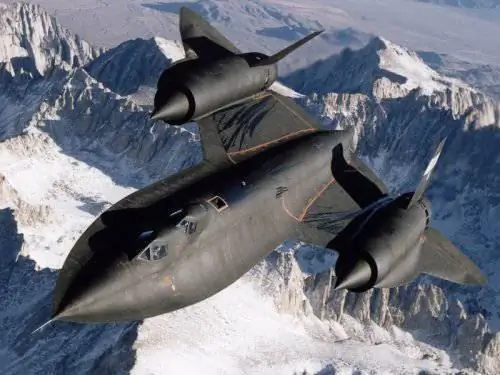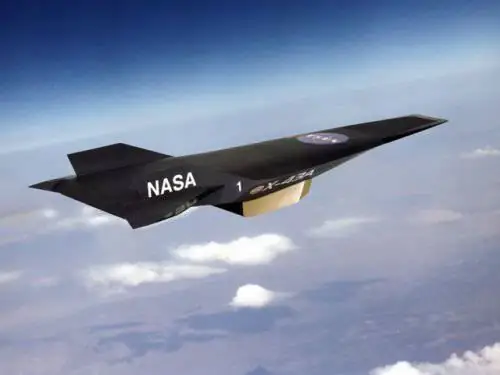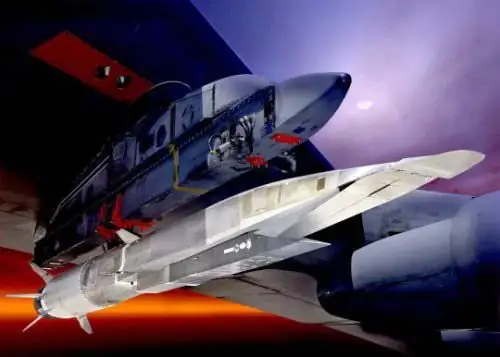- Author Matthew Elmers [email protected].
- Public 2023-12-16 21:49.
- Last modified 2025-01-24 09:17.

The US Air Force tested the X-51A Waverider, which managed to gain speed 5 times the speed of sound, and was able to fly for more than 3 minutes, setting a world record previously held by Russian developers. The test was generally successful, hypersonic weapons are ready to race.
On May 27, 2010, the X-51A Waverider (loosely translated as a wave flight, and in “involuntary” as a surfer) was dropped from a B-52 bomber over the Pacific Ocean. The X-51A booster stage, borrowed from the well-known ATCAMS rocket, brought the Waverider to an altitude of 19.8 thousand meters, where a hypersonic ramjet engine (GPRVD, or scrumjet) was turned on. After that, the rocket rose to a height of 21, 3 thousand meters and picked up a speed of Mach 5 (5 M - five speeds of sound). In total, the rocket engine worked for about 200 seconds, after which the X-51A sent a signal to self-destruct in connection with the outbreak of telemetry interruptions. According to the plan, the rocket was supposed to develop a speed of 6 M (according to the project, the speed of the X-51 was 7 M, that is, over 8000 km / h), and the engine had to work for 300 seconds.
The tests were not perfect, but this did not prevent them from becoming an outstanding achievement. The engine operation time exceeded three times the previous record (77 s), held by the Soviet (later Russian) flying laboratory "Kholod". The 5M speed was first achieved with conventional hydrocarbon fuel, and not with some "exclusive" like hydrogen. Waverider used the JP-7 low-vapor kerosene used on the famous SR-71 ultra-high-speed reconnaissance aircraft.

What is a Scrumjet and what is the essence of the current achievements? In principle, ramjet engines (ramjet engines) are much simpler than turbojet engines (turbojet engines) that are familiar to all. A ramjet engine is simply an air intake (the only moving part), a combustion chamber and a nozzle. In this it compares favorably with jet turbines, where a fan, a compressor and a turbine itself are added to this elementary scheme, invented back in 1913, by combined efforts to drive air into the combustion chamber. In ramjet engines, this function is performed by the oncoming air flow itself, which immediately eliminates the need for sophisticated designs operating in a stream of hot gases and other expensive joys of a turbojet life. As a result, ramjet engines are lighter, cheaper, and less sensitive to high temperatures.
However, simplicity comes at a price. Direct-flow engines are ineffective at subsonic speeds (up to 500-600 km / h do not work at all) - they simply do not have enough oxygen, and therefore they need additional engines that accelerate the apparatus to effective speeds. Due to the fact that the volume and pressure of the air entering the engine is limited only by the diameter of the air intake, it is extremely difficult to effectively control the engine thrust. Ramjet engines are usually "sharpened" for a narrow range of operating speeds, and outside of it they begin to behave inadequately. Because of these inherent deficiencies at subsonic speeds and moderate supersonic, turbojet engines radically outperform their direct-flow competitors.
The situation changes when the agility of the aircraft goes off scale for 3 swings. At high flight speeds, the air is compressed so much in the inlet of the engine that the need for a compressor and other equipment disappears - more precisely, they become a hindrance. But at these speeds, supersonic ramjet engines SPRVD ("ramjet") feel great. However, as the speed increases, the benefits of the free "compressor" (supersonic airflow) turn into a nightmare for engine designers.
In turbojet and SPVRD kerosene burns at a relatively low flow rate - 0.2 M. This allows you to achieve good mixing of air and injected kerosene and, accordingly, high efficiency. But the higher the speed of the incoming stream, the more difficult it is to slow down and the higher the losses associated with this exercise. Starting from 6 M, the flow has to be slowed down 25-30 times. All that remains is to burn fuel in a supersonic flow. This is where the real difficulties begin. When air enters the combustion chamber at a speed of 2.5-3 thousand km / h, the process of maintaining combustion becomes similar, according to one of the developers, to "trying to keep a match lit in the middle of a typhoon." Not so long ago it was believed that in the case of kerosene this is impossible.
The problems of the developers of hypersonic vehicles are by no means limited to the creation of an efficient GPRVD. They also need to overcome the so-called thermal barrier. The airplane heats up from friction against the air, and the heating intensity is directly proportional to the square of the flow velocity: if the speed doubles, then the heating increases fourfold. The heating of an aircraft in flight at supersonic speeds (especially at low altitudes) is sometimes so great that it leads to the destruction of the structure and equipment.
When flying at a speed of 3 M, even in the stratosphere, the temperature of the entrance edges of the air intake and leading edges of the wing is more than 300 degrees, and the rest of the skin - more than 200. The device with a speed of 2-2.5 times more will warm up 4-6 times more. At the same time, even at temperatures of about 100 degrees, organic glass softens, at 150 - the strength of duralumin is significantly reduced, at 550 - titanium alloys lose the necessary mechanical properties, and at temperatures above 650 degrees, aluminum and magnesium melt, steel softens.
The high level of heating can be solved either by passive thermal protection, or by active heat removal by using the fuel reserves on board as a cooler. The problem is that with a very decent "cooling" ability of kerosene - the heat capacity of this fuel is only half that of water - it does not tolerate high temperatures well, and the volumes of heat that need to be "digested" are simply monstrous.
The most straightforward way to solve both problems (supersonic combustion and cooling) is to abandon kerosene in favor of hydrogen. The latter burns relatively readily - in comparison with kerosene, of course - even in a supersonic flow. At the same time, liquid hydrogen is, for obvious reasons, also an excellent cooler, which makes it possible not to use massive thermal protection and at the same time ensure an acceptable temperature on board. In addition, hydrogen has three times the calorific value of kerosene. This makes it possible to raise the limit of achievable speeds up to 17 M (maximum on hydrocarbon fuel - 8 M) and at the same time make the engine more compact.
It is not surprising that most of the previous record-breaking hypersonic aircraft flew precisely on hydrogen. Hydrogen fuel was used by our flying laboratory "Kholod", which so far occupies the second place in terms of the duration of the scramjet engine (77 s). To him, NASA owes a record speed for jet vehicles: in 2004, the NASA X-43A unmanned hypersonic aircraft reached a speed of 11,265 km / h (or 9.8 M) at a flight altitude of 33.5 km.

The use of hydrogen, however, leads to other problems. One liter of liquid hydrogen weighs only 0.07 kg. Even taking into account the three times greater "energy capacity" of hydrogen, this means a fourfold increase in the volume of fuel tanks with a constant amount of stored energy. This results in inflating the size and weight of the apparatus as a whole. In addition, liquid hydrogen requires very specific operating conditions - "all the horrors of cryogenic technologies" plus the specificity of hydrogen itself - it is extremely explosive. In other words, hydrogen is an excellent fuel for experimental vehicles and piece machines like strategic bombers and reconnaissance aircraft. But as a fuel for mass weapons capable of being based on conventional platforms like a normal bomber or destroyer, it is unsuitable.
All the more significant is the achievement of the creators of the X-51, who managed to do without hydrogen and at the same time achieve impressive speeds and record indicators for the duration of flight with a ramjet engine. Part of the record is due to an innovative aerodynamic design - that very wave flight. The strange angular appearance of the apparatus, its wild-looking design creates a system of shock waves, it is they, and not the body of the apparatus, that become the aerodynamic surface. As a result, the lifting force arises with minimal interaction of the incident flow with the body itself and, as a result, the intensity of its heating decreases sharply.
The X-51 has a black carbon-carbon high temperature heat shield located only at the very tip of the nose and at the rear of the underside. The main part of the body is covered with a white low-temperature heat shield, which indicates a relatively gentle heating mode: and this is at 6-7 M in fairly dense layers of the atmosphere and inevitable dives into the troposphere to the target.
Instead of a hydrogen "monster", the American military has acquired a device powered by practical aviation fuel, which immediately takes it out of the field of amusing experiment into the realm of real application. Before us is no longer a demonstration of technology, but a prototype of a new weapon. If the X-51A successfully passes all the tests, in a few years the development of a full-fledged combat version of the X-51A +, equipped with the most modern electronic filling, will begin.

According to preliminary plans of Boeing, X-51A + will be equipped with devices for rapid identification and destruction of targets in conditions of active opposition. The ability to control the vehicle using a modified JDAM interface designed for targeting high-precision ammunition was successfully tested during preliminary tests last year. The new wave aircraft fits well into the standard dimensions for American missiles, that is, it safely fits into shipboard vertical launch devices, transport-launch containers and bomber bays. Note that the ATCAMS rocket, from which the booster stage for the Waverider was borrowed, is an operational-tactical weapon used by the American MLRS multiple launch rocket systems.

Thus, on May 12, 2010, over the Pacific Ocean, the United States tested a prototype of a completely practical hypersonic cruise missile, judging by the planned filling, designed to destroy highly protected ground targets (the estimated range is 1600 km). Perhaps, over time, surface ones will be added to them. In addition to the tremendous speed, such missiles will have a high penetrating ability (by the way, the energy of a body accelerated to 7 M is practically equivalent to a TNT charge of the same mass) and - an important property of statically unstable waves - the ability to very sharp maneuvers.
This is far from the only promising profession of hypersonic weapons.
In the late 1990s, reports from the NATO Space Research and Development Advisory Group (AGARD) noted that hypersonic missiles should have the following applications:
- defeat fortified (or buried) enemy targets and complex ground targets in general;
- air defense;
- the conquest of air supremacy (such missiles can be considered an ideal means of intercepting high-flying air targets at long distances);
- anti-missile defense - interception of launching ballistic missiles at the initial stage of the trajectory.
- use as reusable drones both for striking ground targets and for reconnaissance.
Finally, it is clear that hypersonic missiles will be the most effective - if not the only - antidote against hypersonic attack weapons.
Another direction in the development of hypersonic weapons is the creation of small-sized solid-propellant scramjet engines mounted in projectiles designed to destroy air targets (calibers 35-40 mm), as well as armored vehicles and fortifications (kinetic ATGMs). In 2007, Lockheed Martin completed tests of a prototype kinetic anti-tank missile CKEM (Compact Kinetic Energy Missile). Such a missile at a distance of 3400 m successfully destroyed the Soviet T-72 tank, equipped with improved reactive armor.
In the future, even more exotic designs may appear, for example, transatmospheric aircraft capable of suborbital flights at an intercontinental range. Maneuvering hypersonic warheads for ballistic missiles are quite relevant - and in the short term, too. In other words, in the next 20 years, military affairs will change dramatically and hypersonic technologies will become one of the most important factors in this revolution.






